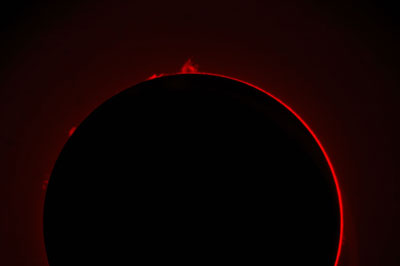The Sun changes over time. With a neutral density filter as the Astro Solar film you can see the sunspots. They are cooler regions on the Sun‘s surface, which therefore appear less bright than the rest of the Sun. About every eleven years there is a maximum, between this time the number of spots decreases, and sometimes you will see a completely spotless Sun. During a maximum, very large spot groups can be seen even without binoculars but only with the aid of eclipse glasses. These groups may be up to 186,000 miles (300,000 kilometers) in diameter. The individual spots are much larger than our Earth. By comparison, the solar diameter approximately equals 109 diameters of the Earth.
If you watch the sunspots for some days, you can nicely see the rotation of the Sun seen around its axis. The spots migrate over the surface of the Sun from east to west and can change their shape within a few hours.

In addition to the sunspots you can detect even the limb darkening of the Sun through a good filter. The edge of the Sun appears less bright than the center. The reason for this lies in the absorption of sunlight in the solar atmosphere.
Faculae are brighter regions on the solar surface, but most are rather small and remain reserved for higher magnification devices. They can be observed best near the solar limb with the help of a telescope and may prefigure a sunspot.

The prominences – large gas clouds that hover above the Sun – can be observed only with a special H-alpha telescope filter. Such complicated filters do not exist for binoculars and they would be pointless because of the low magnification.
The granules can also only be observed in a telescope, because you need higher magnification for them.
The solar corona – the “upper atmosphere“ of our Sun – can only be observed during solar eclipses, when the Sun disappears behind the Moon. The corona has a diameter of about 10°, which is twenty times the diameter of the Sun. Also prominences can be observed during a solar eclipse for a short time. However, you should mount the filter before the end of totality again to avoid damage to your eyesight.
Even rarer than eclipses are transits of Venus or Mercury in front of the Sun. Here, one of the two inner planets passes between Earth and the Sun. Then, it can be seen for a few hours as a black spot in front of the solar disk. Venus transits happen about twice per century (in this century on June 8th, 2004 and on June 6th, 2012, the next will be on December 11th, 2117 and on December 8th, 2125), Mercury transits are slightly more common. The Mercury transit of November 8th 2006 was invisible from North America, but the transits on May 9th 2016 and on November 11th 2019 can be observed from North America, at least partially.
Since Mercury is smaller than Venus, these events will be very unspectacular. Transits were previously used to determine the distance from the Sun. Today they have primarily historical interest. Most interesting are the contacts of the planets with the solar disk.
